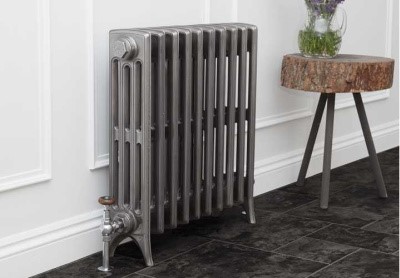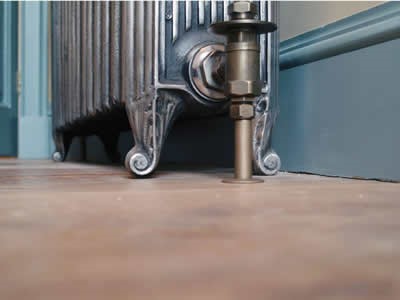Posted: Monday, September 14, 2020

As autumn arrives and winter draws nearer, checking on the performance of your radiators is vital - and that includes bleeding your radiators.
Next time you check your boiler and central heating for any potential cold spots - a standard procedure at this time of year - you may need to bleed your radiators. This is all part of making sure your heating is winter-ready. You don’t want to switch your heating on later in the year and find it’s not working properly. So, how do you bleed a radiator?
Well, Trads is here to help guide you through the process, what it is and why it’s so important to do...
Bleeding a radiator is only a phrase. What you’re really doing is releasing any trapped air from inside the radiators. This may have happened because air bubbles have become trapped due to switching-off your radiators over the summer.
Bleeding the radiators, along with balancing, will ensure they warm up properly and work efficiently. Therefore, they reduce any strain on your boiler and avoid potential issues which can be expensive. You can do this without an engineer but you’ll need old towels and a container to catch any water. This is where the term ‘bleeding’ comes from.
Nothing beats waking up or coming home to a warm house when the weather is cold in autumn and winter.
However, if your radiators stay cold after you’ve switched your heating system on you may well need some help. As well as leaving you shivering, radiators that fail to warm up properly or at all can also indicate wider problems, such as debris in the system causing blockages or a poor system set up. A radiator may be cold for a number of reasons, which we’ve outlined below.
Check your heating to make sure that it is in the right setting and working properly. You should also make sure there is no fault code displaying on your boiler. A fault code may be a little more complicated to deal with.
If your heating has a heat pump, ensure that it’s working. If the pump has stopped working, it will no longer heat the water needed to keep your radiators warm and result in all radiators losing temperature. The easiest way to check if a heat pump is working is to see if it’s making any noise.
If one or more radiators in your home are cold after turning the heating on, this may be a sign there is air in the system. Air in the heating tends to gather at higher points and prevents the distribution of water, which is why the bottom of a radiator will be warm but not the top.
A cold radiator can often be caused by a stuck valve. This will often be the case if the problem is with just one radiator. The thermostatic valve, the white one that controls the flow of water, can become seized due to age or lack of use.
If your boiler and pump are working, then your water pressure may be at fault by being too low. The correct pressure is usually around 1.5 - 2 bar. This is often indicated on the gauge and you may need to balance your system to fix it.
Most radiators will need bleeding during their lifetime. Once trapped inside, the air can stop your radiators heating up to the best of their ability, making your energy usage less efficient.
Bleeding your radiators ensures your heating is functioning to the best of its ability and you aren’t wasting money on your energy bills. You should, ideally, balance your radiators at the same time as bleeding because the processes are linked.
You do this after checking your heating. Turn your heating up and leave the system on for 30 minutes, checking all the radiators have come on and are evenly warm. If your radiators are only hot at the top or at the bottom or some take longer than others to warm up, then they will need to be rebalanced.
You should bleed your radiators as soon as you notice a problem with them. This ensures your heating system is running as efficiently as possible and you’re not wasting money on energy that isn’t turning into heat.
Summer and early autumn - when temperatures are warmer and engineers are less in demand - is a good time to check they are all heating up properly. Then, if you need to, you can bleed them to make sure you’re ready for the colder months ahead. A quick annual check is a good routine to get into.
There isn’t a set length of time for bleeding radiators, most will need bleeding until the hissing sound of the escaping air stops. At this point, water should be leaking out steadily, with no air bubbles or spitting. Exactly how long this takes depends on the size of your radiator - it could vary anywhere from a few seconds to a minute.

Still have questions about how to bleed a radiator? Read our FAQs for more information...
There are a few signs that would suggest your radiator is in need of bleeding, including:
If you notice any of these signs, it’s a good idea to try bleeding your radiator first - if bleeding doesn’t help, there might be something else wrong with them.
A little bit of water should come out when you bleed your radiator, but you shouldn’t bleed all of the water away. The main purpose of bleeding your radiator is to release the air, so close the valve as soon as the water starts leaking without any bubbles.
If you have to bleed your cold radiator frequently and air is repeatedly coming out with no sign of water, there could be another issue with your radiator. If you are sure the boiler pressure isn’t too low, it could be that you need to balance your radiators.
If this still doesn’t help, there could be a build-up of sludge inside the radiator. Call a plumber for advice, or perhaps it is time to replace your radiator with a nice new one!
You should bleed the ground floor first radiator first, starting with the one furthest away from the boiler and working backwards.
Most of the time, you do need a radiator key. However, if you have lost yours, you can easily find a replacement at a DIY or hardware store.
Some radiator bleed valves can be turned with a flathead screwdriver, however, a radiator key often makes the job much easier.
No - you don’t want to risk any boiling water shooting out at you. It’ll also help you bleed the radiators most effectively, as the water inside will have settled.
Put your heating on at least a couple of hours before you plan on bleeding your radiators. This allows the pressure to build up inside them and gives you a chance to identify which radiators are a problem. Then, turn it off and wait until they are cooled down before beginning the bleeding process.
Yes, bleeding your radiators can reduce boiler pressure as you have released some of the water out of the system. This is easily put right though - just top up the pressure again with the filling loop on your boiler.
If your boiler pressure has dropped after bleeding your radiators, return it to the recommended level (usually 1.5 to 2.0 bar), or you might find your radiators are still cold. If your boiler pressure looks ok and your radiators are still cold, try repeating the bleed process again for a second time.
Is it time you updated your radiators? Here at Trads, we have an excellent range of beautiful cast iron and steel radiators to update your home with!
Feel free to contact us if you need any help choosing a radiator
< Back To Blog